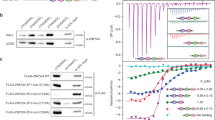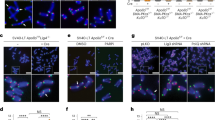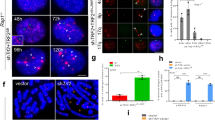Abstract
Telomeres allow cells to distinguish natural chromosome ends from damaged DNA and protect the ends from degradation and fusion. In human cells, telomere protection depends on the TTAGGG repeat binding factor, TRF2 (refs 1–4), which has been proposed to remodel telomeres into large duplex loops5 (t-loops). Here we show by nanoelectrospray tandem mass spectrometry that RAD50 protein is present in TRF2 immunocomplexes. Protein blotting showed that a small fraction of RAD50, MRE11 and the third component of the MRE11 double-strand break (DSB) repair complex, the Nijmegen breakage syndrome protein (NBS1), is associated with TRF2. Indirect immunofluorescence demonstrated the presence of RAD50 and MRE11 at interphase telomeres. NBS1 was associated with TRF2 and telomeres in S phase, but not in G1 or G2. Although the MRE11 complex accumulated in irradiation-induced foci (IRIFs) in response to γ-irradiation, TRF2 did not relocate to IRIFs and irradiation did not affect the association of TRF2 with the MRE11 complex, arguing against a role for TRF2 in DSB repair. Instead, we propose that the MRE11 complex functions at telomeres, possibly by modulating t-loop formation.
This is a preview of subscription content, access via your institution
Access options
Subscribe to this journal
Receive 12 print issues and online access
$209.00 per year
only $17.42 per issue
Buy this article
- Purchase on Springer Link
- Instant access to full article PDF
Prices may be subject to local taxes which are calculated during checkout




Similar content being viewed by others
References
Broccoli, D., Smogorzewska, A., Chong, L. & de Lange, T. Human telomeres contain two distinct Myb-related proteins, TRF1 and TRF2. Nature Genet. 17, 231–235 (1997).
Bilaud, T. et al. Telomeric localization of TRF2, a novel human telobox protein. Nature Genet. 17, 236–239 (1997).
van Steensel, B., Smogorzewska, A. & de Lange, T. TRF2 protects human telomeres from end-to-end fusions. Cell 92, 401–413 (1998).
Karlseder, J., Broccoli, D., Dai, Y., Hardy, S. & de Lange, T. p53- and ATM-dependent apoptosis induced by telomeres lacking TRF2. Science 283, 1321–1325 (1999).
Griffith, J.D. et al. Mammalian telomeres end in a large duplex loop. Cell 97, 503–514 (1999).
Wilm, M. et al. Femtomole sequencing of proteins from polyacrylamide gels by nano-electrospray mass spectrometry. Nature 379, 466–469 (1996).
Li, B., Oestreich, S. & de Lange, T. Identification of human Rap1: implications for telomere evolution. Cell 101, 471–483 (2000).
Dolganov, G.M. et al. Human Rad50 is physically associated with hMre11: identification of a conserved multiprotein complex implicated in recombinational DNA repair. Mol. Cell. Biol. 16, 4832–4841 (1996).
Carney, J.P. et al. The hMre11/hRad50 protein complex and Nijmegen Breakage Syndrome: linkage of double-strand break repair to the cellular DNA damage response. Cell 93, 477–486 (1998).
Haber, J.E. The many interfaces of Mre11. Cell 95, 583–586 (1998).
Nelms, B.E., Maser, R.S., MacKay, J.F., Lagally, M.G. & Petrini, J.H.J. In situ visualization of DNA double-strand break repair in human fibroblasts. Science 280, 590–592 (1998).
Lim, D.-S. et al. ATM phosphorylates p95/nbs1 in an S-phase checkpoint pathway. Nature 404, 613–617 (2000).
Bressan, D.A., Baxter, B.K. & Petrini, J.H.J. The Mre11/Rad50/Xrs2 protein complex facilitates homologous recombination-based double strand break repair in Saccharomyces cerevisiae. Mol. Cell. Biol. 19, 7681–7687 (1999).
Usui, T., Ohta, T., Oshiumi, J., Ogawa, T.H. & Ogawa, T. Complex formation and functional versatility of Mre11 of budding yeast in recombination. Cell 95, 705–716 (1998).
Nugent, C. et al. Telomere maintenance is dependent on activities required for end repair of double-strand breaks. Curr. Biol. 8, 657–660 (1998).
Boulton, S.J. & Jackson, S.P. Components of the Ku-dependent non-homologous end-joining pathway are involved in telomeric length maintenance and telomeric silencing. EMBO J. 17, 1819–1828 (1998).
Le, S., Moore, J.K., Haber, J.E. & Greider, C.W. RAD50 and RAD51 define two pathways that collaborate to maintain telomeres in the absence of telomerase. Genetics 152, 143–152 (1999).
Xiao, Y. & Weaver, D.T. Conditional gene targeted deletion by Cre recombinase demonstrates the requirement for the double-strand break repair Mre11 protein in murine embryonic stem cells. Nucleic Acids Res. 25, 2985–2991 (1997).
Luo, G. et al. Disruption of mRad50 causes ES cell lethality, abnormal embryonic development and sensitivity to ionizing radiation. Proc. Natl Acad. Sci. USA 96, 7376–7381 (1999).
van Steensel, B. & de Lange, T. Control of telomere length by the human telomeric protein TRF1. Nature 385, 740–743 (1997).
Chong, L. et al. A human telomeric protein. Science 270, 1663–1667 (1995).
Maser, R.S., Monsen, K.J., Nelms, B. & Petrini, J.H.J. hMre11 and hRad50 nuclear foci are induced during the normal cellular response to DNA double-strand breaks. Mol. Cell. Biol. 17, 6087–6096 (1997).
Bryan, T.M., Englezou, A., Gupta, J., Bacchetti, S. & Reddel, R.R. Telomere elongation in immortal human cells without detectable telomerase activity. EMBO J. 14, 4240–4248 (1995).
Yeager, T.R. et al. Telomerase-negative immortalized human cells contain a novel type of promyelocytic leukemia (PML) body. Cancer Res. 59, 4175–4179 (1999).
Stewart, G. et al. The DNA double strand break repair gene hMre11, is mutated in individuals with a new ataxia telangiectasia like disorders (ATLD). Cell 99, 577–587 (1999).
Martin, S.G., Laroche, T., Suka, N., Grunstein, M. & Gasser, S.M. Relocalization of telomeric Ku and Sir proteins in response to DNA strand breaks in yeast. Cell 97, 621–633 (1999).
Mills, K.D., Sinclair, D.A. & Guarente, L. Mec1-dependent redistribution of the Sir3 silencing protein from telomeres to DNA double-strand breaks. Cell 97, 609–620 (1999).
Moore, J.K. & Haber, J.E. Cell cycle and genetic requirements of two pathways of nonhomologous end-joining repair of double-strand breaks in Saccharomyces cerevisiae. Mol. Cell. Biol. 16, 2164–2173 (1996).
Paull, T.T. & Gellert, M. Nbs1 potentiates ATP-driven DNA unwinding and endonuclease cleavage by the Mre11/Rad50 complex. Genes Dev. 13, 1276–1288 (1999).
Harley, C.B. Telomeres and aging. in Telomeres (eds Blackburn, E.H. & Greider, C.W.) 247–265 (Cold Spring Harbor Press, Cold Spring Harbor, New York, 1995).
Shevchenko, A., Wilm, M., Vorm, O. & Mann, M. Mass spectrometric sequencing of proteins silver-stained polyacrylamide gels. Anal. Chem. 68, 850–858 (1996).
Shevchenko, A. et al. Rapid ‘de novo’ peptide sequencing by a combination of nanoelectrospray, isotopic labeling and a quadrupole/time-of-flight mass spectrometer. Rapid Commun. Mass Spectrom. 11, 1015–1024 (1997).
Mann, M. & Wilm, M. Error-tolerant identification of peptides in sequence databases by peptide sequence tags. Anal. Chem. 66, 4390–4399 (1994).
Acknowledgements
We thank N. Heintz and W. Lee for HeLa nuclear extract; J. Karlseder for help with FACS analysis, pCDNA3-TRF2ΔBΔM and comments on the manuscript; A. Smogorzewska for HeLa cells infected with TRF2ΔBΔM retrovirus and comments on the manuscript; and B. Li, G. Celli, S. Smith and J. Ye for discussion. X.-D.Z. is supported by a Canadian MRC postdoctoral fellowship. B.K. was supported (in part) by a long-term post-doctoral fellowship from the EMBO. The laboratory of M.M. at the University of Southern Denmark is supported by a grant from the Danish National Research Foundation to the Center of Experimental BioInformatics (CEBI). J.H.J.P. is supported by NIH/NCI GM56888, GM59413 and the Milwaukee Foundation. This work was supported by a grant from the NIH (GM49046) to T.d.L.
Author information
Authors and Affiliations
Corresponding author
Rights and permissions
About this article
Cite this article
Zhu, XD., Küster, B., Mann, M. et al. Cell-cycle-regulated association of RAD50/MRE11/NBS1 with TRF2 and human telomeres. Nat Genet 25, 347–352 (2000). https://doi.org/10.1038/77139
Received:
Accepted:
Issue Date:
DOI: https://doi.org/10.1038/77139
This article is cited by
-
Inhibition of MRN activity by a telomere protein motif
Nature Communications (2021)
-
RAD50 deficiency is a predictor of platinum sensitivity in sporadic epithelial ovarian cancers
Molecular Biomedicine (2020)
-
DNA damage response signaling pathways and targets for radiotherapy sensitization in cancer
Signal Transduction and Targeted Therapy (2020)
-
NBS1 interacts with HP1 to ensure genome integrity
Cell Death & Disease (2019)
-
Mutual interactions between telomere heterogeneity and cell culture growth dynamics shape stochasticity of cell aging
Biogerontology (2018)



